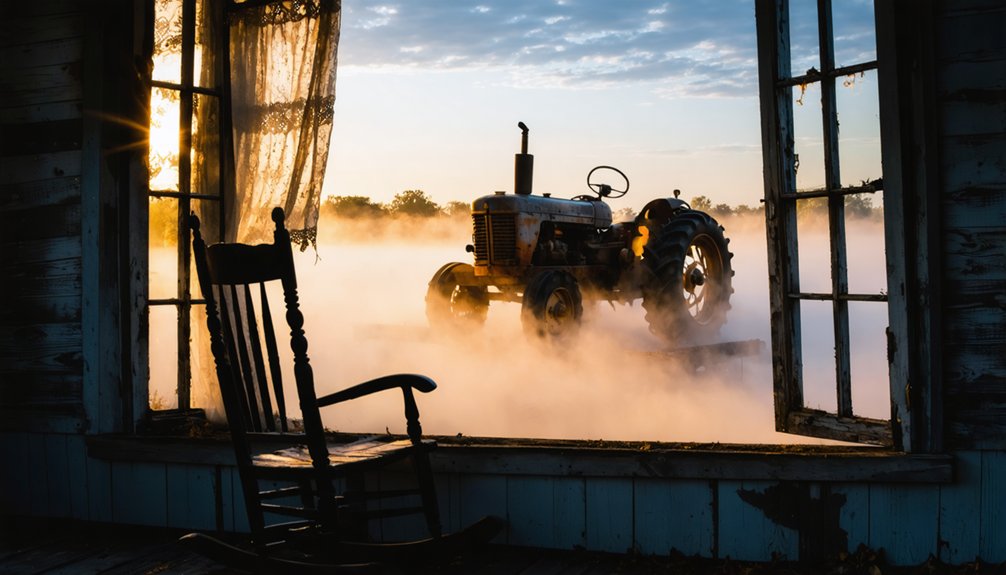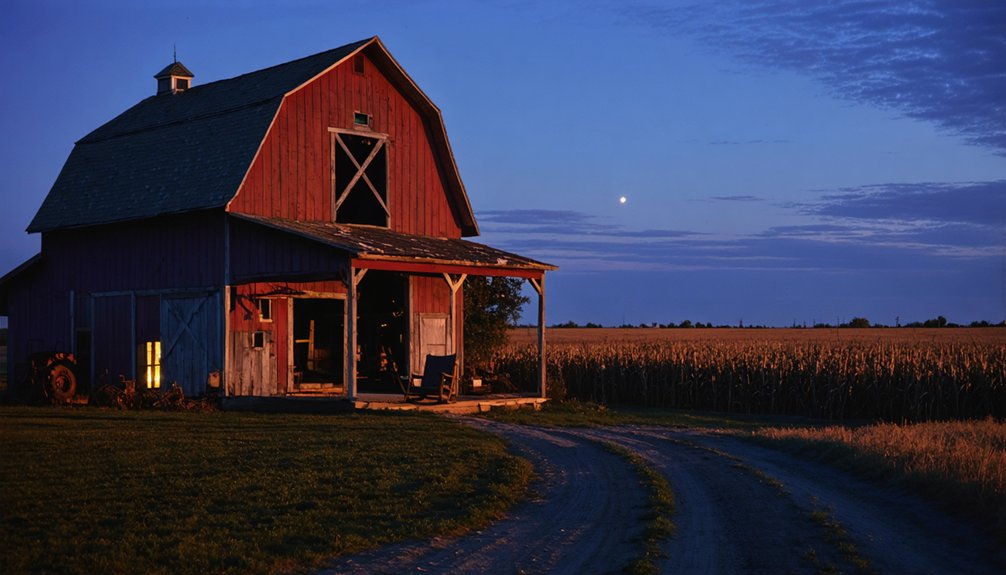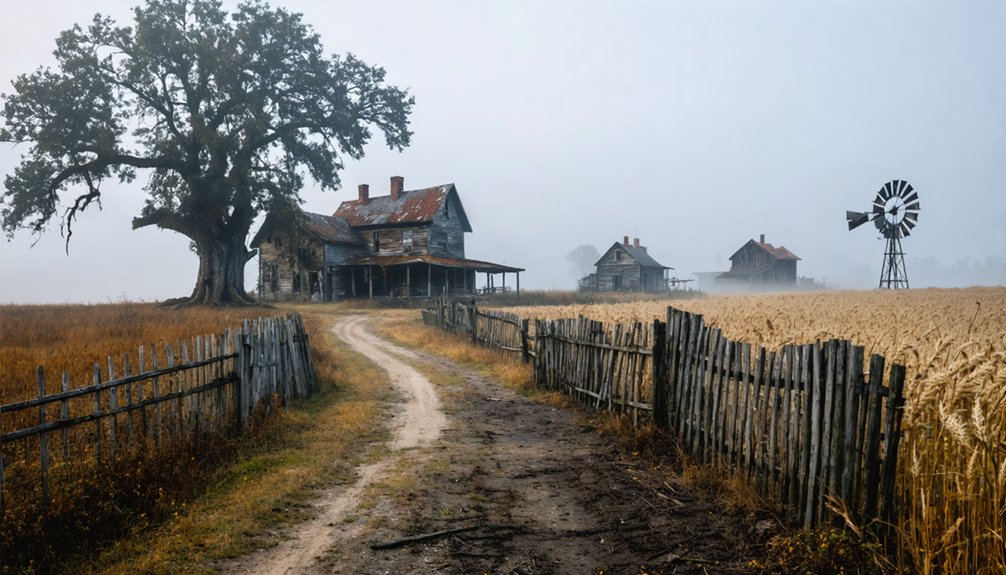Connecting with spirits in abandoned farming towns requires respectful engagement with both place and history. You’ll find spectral encounters peak during dawn and dusk, particularly in spring and autumn when temperature fluctuations intensify psychophysical phenomena. Always obtain permissions before investigating, and approach with reverence for the cultural significance of agricultural apparitions. Documented patterns suggest grief-centered manifestations appear strongest near sites of community trauma, where the whispers of the past await patient listeners.
Key Takeaways
- Visit during spring or autumn when spiritual manifestations peak alongside agricultural cycles, especially during misty dawns or foggy dusks.
- Research the town’s history and specific traumas before visiting to better understand potential spiritual encounters and their cultural context.
- Approach abandoned sites with explicit permission and reverence, respecting both physical spaces and spiritual energies present.
- Listen for narratives connecting to agricultural cycles, as spectral manifestations often relate to planting, harvesting, or communal gathering spaces.
- Document experiences through community storytelling sessions, collaborating with local elders who maintain oral histories of spiritual encounters.
The Historical Roots of Rural Hauntings
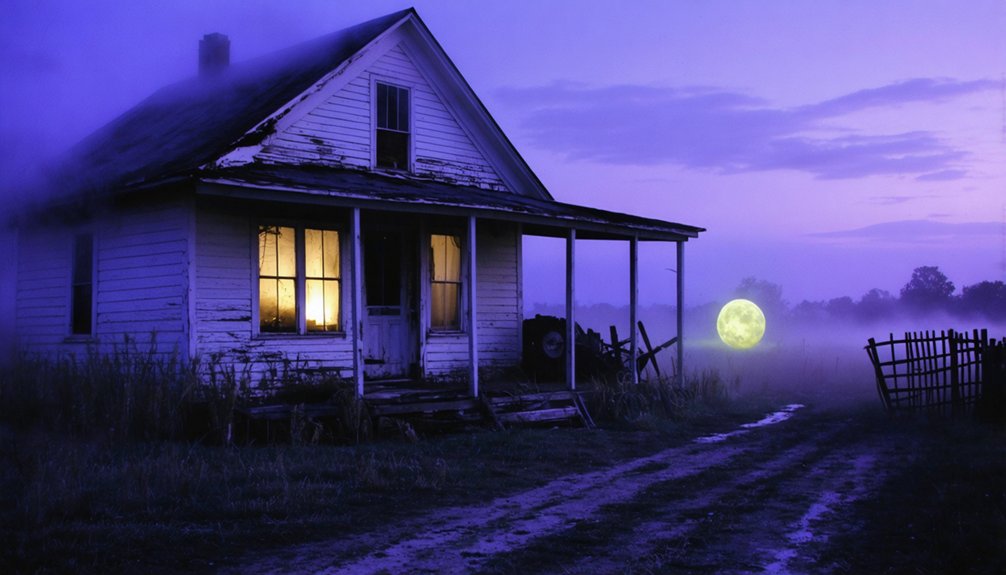
While ancient spectral beliefs have existed across cultures for millennia, the particular character of rural American hauntings emerges from a complex tapestry of historical suffering, cultural collision, and environmental isolation.
You’ll find that ghostly folklore in abandoned farming towns often traces back to institutions like poor farms—places where society’s unwanted endured harsh conditions before death. The Floyd County Asylum established in 1838 served as one such poor farm where the destitute and mentally ill found refuge.
When you investigate these spectral narratives, you’ll uncover how European settlers’ religious fears merged with Indigenous spiritual perspectives, creating uniquely American haunting traditions.
The violent aftermath of war, especially Civil War battlefields near rural settlements, left emotional imprints on landscapes that persist today. Both Black and white storytellers contributed equally to these ghostly tales, despite misconceptions that ghost knowledge belonged exclusively to one racial group over another.
These stories aren’t merely entertainment; they’re cultural artifacts documenting actual tragedies—disease outbreaks, poverty, and isolation—that befell communities before abandonment.
Each abandoned town carries these layered histories, waiting for you to decode their ghostly significance.
You’ll find the once-maintained farm paths now consumed by encroaching vegetation, creating natural barriers that challenge your navigation through these forgotten spaces.
What were previously clear access routes connecting homesteads to fields now exist as ghostly impressions in the landscape, detectable only through careful observation of slight depressions or unusual vegetation patterns.
The transformation of these agricultural arteries represents both the ecological succession described in scientific literature and the erasure of human presence that many residents lament as part of their lost cultural heritage.
In places like Bulgaria and Latvia, these paths are quickly vanishing amid significant farmland abandonment, with some regions seeing over 40% of agricultural land returning to wilderness since the late 1980s.
Artists and photographers often seek out these deteriorating pathways, capturing the haunting beauty where nature reclaims what humans once cultivated.
Silent Farm Trails
Beyond the manicured paths of conventional hiking trails lie the silent farm trails—forgotten arteries of agricultural commerce now reclaimed by nature’s steady hand.
These pathways echo with silent whispers of agricultural history, where concrete silos and weathered foundations tell trail stories more authentic than any historical text.
You’ll encounter these remnants as you traverse landscapes evolving before your eyes:
- Abandoned grain elevators standing sentinel at crossroads of former communities
- Rusted farm implements emerging from encroaching vegetation
- Foundations and cellar holes marking vanished homesteads
- Fields slowly surrendering to forest succession
- Historical markers documenting the rhythm of rural life now silenced
The methodical documentation of these sites reveals a complex narrative—landscapes in progress, communities dispersed, yet paradoxically, ecosystems flourishing in newfound freedom from agricultural intervention. Along Griffin Road in Hillsboro County, the foggy spring morning reveals the strawberry fields’ aroma that lingers as a sensory reminder of the land’s continued agricultural heritage. The Forest Service’s acquisition of former farmlands in the 1960s has transformed places like the historic Garrett Farm into public access areas where hikers can now explore these forgotten agricultural landscapes.
Overgrown Access Routes
Winding through the spectral remnants of America’s forgotten agricultural heartland, overgrown access routes serve as tenuous lifelines to abandoned farming communities that once thrived with human activity.
These historical pathways, often unmarked and unmaintained, follow century-old property boundaries connecting former homesteads.
You’ll find navigation challenging without proper preparation. GPS devices and topographic maps become essential companions, as overgrown vegetation obscures roadbeds that time has reclaimed.
Like the forgotten River Road that reveals crumbling plantations and hidden cemeteries along the Mississippi, these agricultural pathways tell stories of commerce and community that have faded with time.
The seasonal closure of Tripoli Road in early November affects accessibility to abandoned communities like Thornton Gore in the White Mountains.
Seasonal conditions further complicate access—spring rains transform dirt paths into impassable mud, while winter snows erase them entirely.
Exercise caution when exploring these forgotten thoroughfares. Structural hazards like collapsed bridges and wildlife encounters present genuine risks, while emergency services remain distressingly distant.
Many routes cross private lands, requiring permissions that preserve both historical integrity and the ecological corridors these pathways have become.
Documented Spiritual Encounters in Farming Settlements
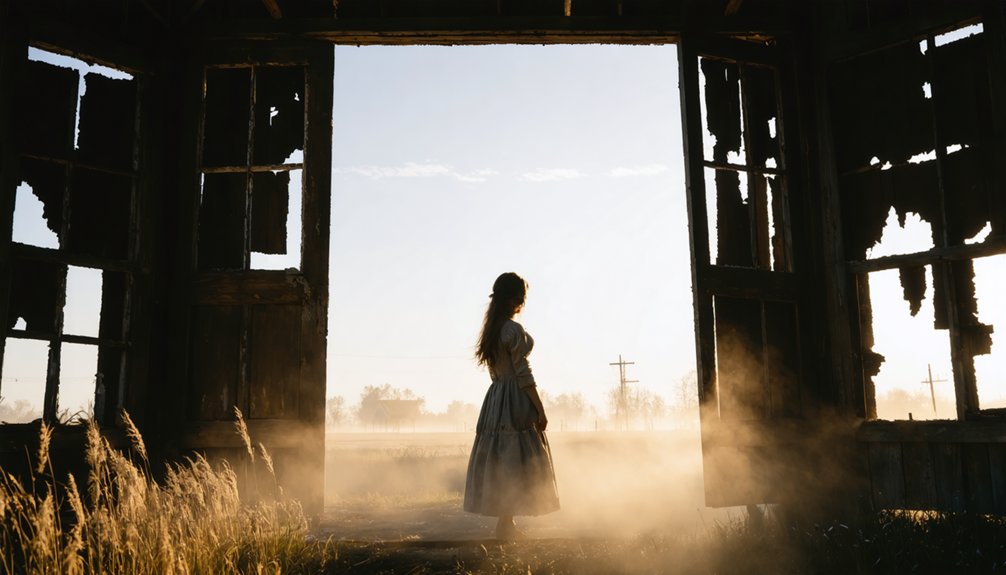
You’ll find that documented spectral manifestations in abandoned agricultural communities often follow predictable seasonal patterns, typically intensifying during harvest periods when the absent rhythms of communal work become most pronounced.
Oral histories collected from remaining elderly residents suggest grief-centered apparitions frequently manifest near sites of significant community trauma, such as foreclosure auctions or locations where families made final departures.
While maintaining scholarly skepticism about supernatural claims, researchers have meticulously cataloged consistent testimonial patterns that connect these manifestations to unresolved collective trauma rather than mere folklore embellishment.
Similar to urban exploration enthusiasts in Asia’s forgotten territories, visitors to these farming settlements often report feeling profound connections to the past through their experiences.
The emotional impact is particularly significant when exploring towns where personal connections to former community members still exist, creating a more intimate and sometimes unsettling experience for visitors with familial ties to these abandoned places.
Seasonal Apparition Patterns
The cyclical nature of apparitional phenomena in abandoned farming settlements reveals itself most prominently during changing periods of the agricultural calendar.
You’ll find that spring apparitions and autumn encounters dominate documented cases, coinciding with traditional planting and harvest cycles when the veil between worlds appears thinnest.
- Misty dawns and foggy dusks enhance visibility of spectral forms moving through forgotten fields
- Temperature fluctuations between day and night intensify psychophysical phenomena
- Wind through abandoned structures creates acoustic anomalies often interpreted as spiritual communication
- Springtime reveals shadowy figures seemingly engaged in eternal planting rituals
- Autumnal manifestations frequently involve spectral gatherings near communal spaces
Winter brings relative quiet to these haunted landscapes, while summer whispers with disembodied voices and phantom machinery sounds—evidence that even spirits adhere to farming’s ancient rhythms.
Oral Tradition Documentation
Folklore’s richest veins often lie not in dusty archives but in the living memories of those who’ve witnessed the inexplicable. When you explore abandoned farming settlements, you’re accessing centuries of undocumented spiritual encounters preserved through oral history.
These narratives follow recognizable patterns: guardian spirits tied to specific locations, agricultural omens, and ancestral presences that transcend time.
Community storytelling sessions have become crucial documentation methods, with researchers employing structured interviews and recording technology to preserve these accounts before they vanish.
You’ll find the most authentic material comes from collaborative projects where historians work alongside community elders. The resulting archives serve dual purposes—validating reported encounters through cross-referencing with archaeological evidence while reinforcing cultural identity.
Through these documented narratives, you’re witnessing the invisible threads connecting past and present stewards of the land.
Grief-Centered Manifestations
When grief permeates abandoned land, it often manifests in spiritual encounters that defy conventional explanation. These grief narratives emerge particularly in farming settlements where communities experienced profound loss through disease, eviction, or environmental decline.
You’ll find spectral connections deeply rooted in historical trauma, with manifestations reflecting unresolved communal sorrow.
- Shadowy figures appear at dusk in deserted cottages where families were forcibly removed for sheep enclosures
- Unexplained sounds of weeping near abandoned parish churches that once sheltered displaced community members
- Temperature fluctuations in locations of documented epidemics that decimated rural populations
- Visual phenomena interpreted as “prairie madness” manifestations in isolated homesteads
- Recurring apparitions tied to specific tragic events, often appearing on anniversary dates of community dispersal
These manifestations serve as emotional echoes of displacement, binding present witnesses to historical suffering through place-based memory.
Preparing for Ethical Ghost Investigation

Ethical considerations form the foundation of any legitimate paranormal investigation, particularly when entering abandoned spaces where both legal and spiritual boundaries intersect.
Before venturing into forgotten farming communities, you must obtain explicit permissions from property owners or local authorities, regardless of how deserted the location appears. These ethical permissions protect both you and the site’s integrity.
Secure permissions first—abandoned doesn’t mean abandoned by law or spirit. Respect protects everyone involved.
Develop respectful practices by researching the town’s history thoroughly, acknowledging the cultural context of former residents.
When attempting spirit communication, introduce yourself clearly and explain your purpose. Never provoke or demand responses.
Honor any conditions set by property custodians, including time restrictions or off-limit areas.
Remember that your presence impacts both the physical space and potentially the spiritual energies residing there—approach with reverence, not entitlement.
The Seasonal Nature of Rural Paranormal Activity
The seasonal rhythms that govern agricultural lands extend beyond crop cycles into the ethereal domain, influencing when and how paranormal phenomena manifest in abandoned rural settings. Your experience investigating these forgotten places will vary dramatically with the changing climate.
Rural legends consistently describe how temperature and humidity shape spectral encounters.
- Heat waves correlate with significant spikes in apparition sightings
- Limestone bedrock creates year-round energy sources for paranormal activity
- Seasonal darkness amplifies supernatural folklore in isolated farming communities
- Cross-seasonal data validates cyclical patterns in paranormal manifestations
- Barometric pressure shifts trigger intensified spirit manifestations
These seasonal fluctuations aren’t merely coincidental—they’re measurable phenomena.
When planning your investigations, track weather patterns alongside paranormal activity to identify ideal conditions for experiencing these rural energetic anomalies.
Cultural Context Behind Agricultural Apparitions
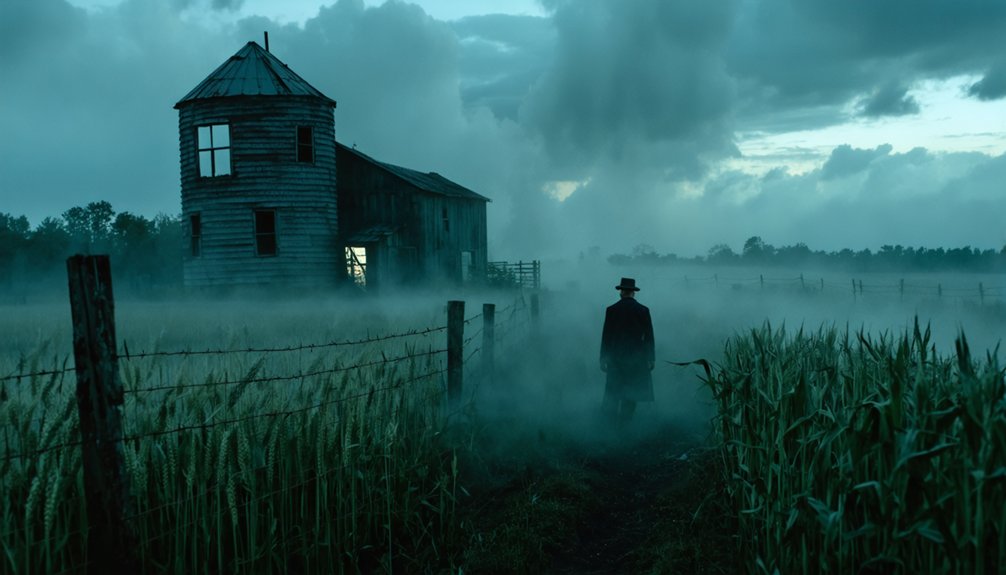
Beyond the seasonal fluctuations that shape spectral encounters lies a rich tapestry of cultural meaning that gives agricultural apparitions their distinctive character and significance. These manifestations aren’t random hauntings but expressions of deeply rooted agricultural beliefs that validate communal identities and religious worldviews.
When you encounter tales of field specters or barn apparitions, you’re witnessing narratives that reinforce spiritual reciprocity between farmers and their land. Communities maintain connections to ancestral wisdom through spirit veneration practices—leaving harvest offerings at gravesites or retelling stories of guardian ghosts who protect family farms.
These traditions embed supernatural elements within cycles of planting, growth, and renewal. Agricultural apparitions serve as cultural anchors, allowing communities to process environmental transformation while preserving oral histories that link present agricultural practices with ancestral cosmologies and fertility cults.
Preservation Efforts and Respectful Visitation
Preserving the decaying remnants of abandoned agricultural communities requires a delicate balance between conservation objectives and respectful engagement with both physical artifacts and spiritual dimensions.
Modern preservation techniques now incorporate collaborative stewardship models that honor both tangible and intangible heritage.
- Follow established visitation ethics: obtain permissions and adhere to “leave no trace” principles
- Support local historical societies actively working to document spectral narratives
- Participate in community-led restoration workshops rather than exploring independently
- Respect boundaries—both physical barriers and energetic thresholds
- Contribute to conservation funds that balance ecological restoration with cultural protection
You’ll find that mindful engagement with these forgotten places yields richer experiences.
When preservation efforts incorporate both environmental stewardship and cultural sensitivity, these haunting landscapes remain accessible while their whispered stories continue to resonate through protected structures and restored landscapes.
Frequently Asked Questions
Can Spirits Attach Themselves to Visitors Who Explore Abandoned Farms?
Like moths to flame, you may experience spirit attachment when exploring abandoned farms. Visitor experiences suggest possible connections, though empirical evidence remains inconclusive—your openness potentially inviting paranormal encounters.
How Do Electromagnetic Fields Affect Paranormal Detection Equipment?
You’ll find electromagnetic fields create significant electromagnetic interference, potentially masking or mimicking genuine paranormal communication. Your detection equipment can’t distinguish between mundane sources and authentic phenomena—scientific skepticism remains essential for truthful documentation.
Are Certain Weather Conditions More Conducive to Spiritual Encounters?
Ever noticed how the veil thins during certain conditions? You’ll find temperature fluctuations and drops in atmospheric pressure often correlate with reported spiritual encounters, though meticulous documentation reveals these remain correlation, not causation.
What Protective Measures Should Investigators Take Against Malevolent Entities?
You’ll need protective rituals and spiritual cleansing before investigating. Carry religious symbols, maintain mental grounding, and document your findings methodically. Don’t provoke entities; your awareness remains your strongest shield against malevolence.
Do Farming Tools or Agricultural Artifacts Increase Paranormal Activity?
Like seeds sown in unfertile soil, claims that farming tools heighten paranormal activity lack scientific foundation. You’ll find artifact significance stems from farming history, not supernatural properties. Evidence remains elusive despite meticulous documentation by investigators.
References
- https://en.wikipedia.org/wiki/Ghost_town
- https://bnu.repository.guildhe.ac.uk/id/eprint/20221/1/20221_Okeeffe.pdf
- https://www.youtube.com/watch?v=4oHlJFXbrCk
- https://research-information.bris.ac.uk/ws/portalfiles/portal/188192720/Final_Copy_2019_01_23_O_Lynn_A_PhD.pdf
- https://www.newmexico.org/places-to-visit/ghost-towns/
- https://en.wikipedia.org/wiki/Ghost_hunting
- https://www.purewow.com/travel/haunted-small-towns
- https://en.wikipedia.org/wiki/List_of_reportedly_haunted_locations
- https://ohioghosttowns.org/top-10-ghost-towns/
- https://edu.dontforgettofeedme.org/!y/chap/dl?PUB=house+of+spirits+and+whispers+the+true+story+of+a+haunted.pdf
